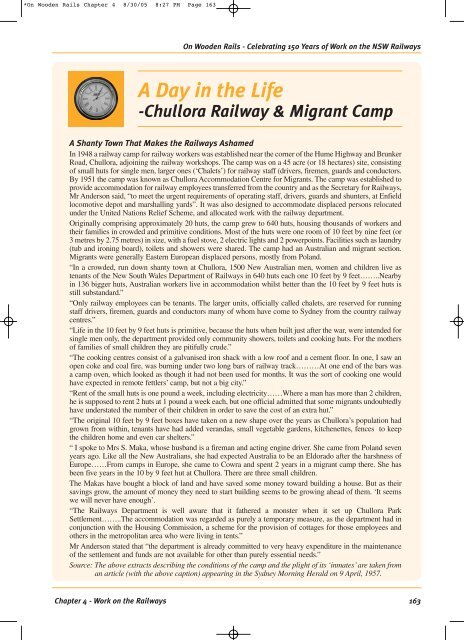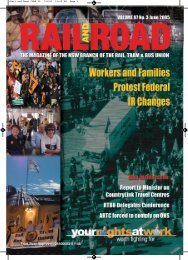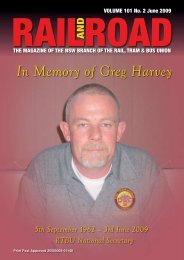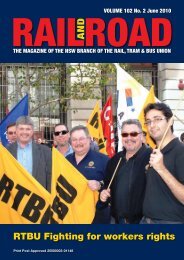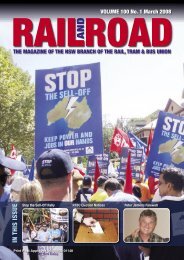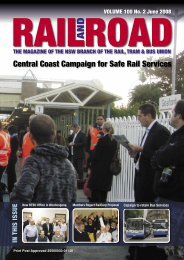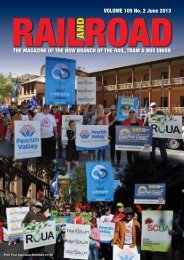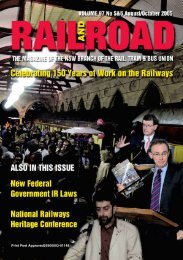Chapter 4 - Work on the Railways - Rail, Tram and Bus Union of NSW
Chapter 4 - Work on the Railways - Rail, Tram and Bus Union of NSW
Chapter 4 - Work on the Railways - Rail, Tram and Bus Union of NSW
Create successful ePaper yourself
Turn your PDF publications into a flip-book with our unique Google optimized e-Paper software.
*On Wooden <strong>Rail</strong>s <str<strong>on</strong>g>Chapter</str<strong>on</strong>g> 4 8/30/05 8:27 PM Page 163<br />
On Wooden <strong>Rail</strong>s - Celebrating 150 Years <strong>of</strong> <str<strong>on</strong>g>Work</str<strong>on</strong>g> <strong>on</strong> <strong>the</strong> <strong>NSW</strong> <strong><strong>Rail</strong>ways</strong><br />
A Day in <strong>the</strong> Life<br />
-Chullora <strong>Rail</strong>way & Migrant Camp<br />
A Shanty Town That Makes <strong>the</strong> <strong><strong>Rail</strong>ways</strong> Ashamed<br />
In 1948 a railway camp for railway workers was established near <strong>the</strong> corner <strong>of</strong> <strong>the</strong> Hume Highway <strong>and</strong> Brunker<br />
Road, Chullora, adjoining <strong>the</strong> railway workshops. The camp was <strong>on</strong> a 45 acre (or 18 hectares) site, c<strong>on</strong>sisting<br />
<strong>of</strong> small huts for single men, larger <strong>on</strong>es (‘Chalets’) for railway staff (drivers, firemen, guards <strong>and</strong> c<strong>on</strong>ductors.<br />
By 1951 <strong>the</strong> camp was known as Chullora Accommodati<strong>on</strong> Centre for Migrants. The camp was established to<br />
provide accommodati<strong>on</strong> for railway employees transferred from <strong>the</strong> country <strong>and</strong> as <strong>the</strong> Secretary for <strong><strong>Rail</strong>ways</strong>,<br />
Mr Anders<strong>on</strong> said, “to meet <strong>the</strong> urgent requirements <strong>of</strong> operating staff, drivers, guards <strong>and</strong> shunters, at Enfield<br />
locomotive depot <strong>and</strong> marshalling yards”. It was also designed to accommodate displaced pers<strong>on</strong>s relocated<br />
under <strong>the</strong> United Nati<strong>on</strong>s Relief Scheme, <strong>and</strong> allocated work with <strong>the</strong> railway department.<br />
Originally comprising approximately 20 huts, <strong>the</strong> camp grew to 640 huts, housing thous<strong>and</strong>s <strong>of</strong> workers <strong>and</strong><br />
<strong>the</strong>ir families in crowded <strong>and</strong> primitive c<strong>on</strong>diti<strong>on</strong>s. Most <strong>of</strong> <strong>the</strong> huts were <strong>on</strong>e room <strong>of</strong> 10 feet by nine feet (or<br />
3 metres by 2.75 metres) in size, with a fuel stove, 2 electric lights <strong>and</strong> 2 powerpoints. Facilities such as laundry<br />
(tub <strong>and</strong> ir<strong>on</strong>ing board), toilets <strong>and</strong> showers were shared. The camp had an Australian <strong>and</strong> migrant secti<strong>on</strong>.<br />
Migrants were generally Eastern European displaced pers<strong>on</strong>s, mostly from Pol<strong>and</strong>.<br />
“In a crowded, run down shanty town at Chullora, 1500 New Australian men, women <strong>and</strong> children live as<br />
tenants <strong>of</strong> <strong>the</strong> New South Wales Department <strong>of</strong> <strong><strong>Rail</strong>ways</strong> in 640 huts each <strong>on</strong>e 10 feet by 9 feet……..Nearby<br />
in 136 bigger huts, Australian workers live in accommodati<strong>on</strong> whilst better than <strong>the</strong> 10 feet by 9 feet huts is<br />
still subst<strong>and</strong>ard.”<br />
“Only railway employees can be tenants. The larger units, <strong>of</strong>ficially called chalets, are reserved for running<br />
staff drivers, firemen, guards <strong>and</strong> c<strong>on</strong>ductors many <strong>of</strong> whom have come to Sydney from <strong>the</strong> country railway<br />
centres.”<br />
“Life in <strong>the</strong> 10 feet by 9 feet huts is primitive, because <strong>the</strong> huts when built just after <strong>the</strong> war, were intended for<br />
single men <strong>on</strong>ly, <strong>the</strong> department provided <strong>on</strong>ly community showers, toilets <strong>and</strong> cooking huts. For <strong>the</strong> mo<strong>the</strong>rs<br />
<strong>of</strong> families <strong>of</strong> small children <strong>the</strong>y are pitifully crude.”<br />
“The cooking centres c<strong>on</strong>sist <strong>of</strong> a galvanised ir<strong>on</strong> shack with a low ro<strong>of</strong> <strong>and</strong> a cement floor. In <strong>on</strong>e, I saw an<br />
open coke <strong>and</strong> coal fire, was burning under two l<strong>on</strong>g bars <strong>of</strong> railway track………At <strong>on</strong>e end <strong>of</strong> <strong>the</strong> bars was<br />
a camp oven, which looked as though it had not been used for m<strong>on</strong>ths. It was <strong>the</strong> sort <strong>of</strong> cooking <strong>on</strong>e would<br />
have expected in remote fettlers’ camp, but not a big city.”<br />
“Rent <strong>of</strong> <strong>the</strong> small huts is <strong>on</strong>e pound a week, including electricity……Where a man has more than 2 children,<br />
he is supposed to rent 2 huts at 1 pound a week each, but <strong>on</strong>e <strong>of</strong>ficial admitted that some migrants undoubtedly<br />
have understated <strong>the</strong> number <strong>of</strong> <strong>the</strong>ir children in order to save <strong>the</strong> cost <strong>of</strong> an extra hut.”<br />
“The original 10 feet by 9 feet boxes have taken <strong>on</strong> a new shape over <strong>the</strong> years as Chullora’s populati<strong>on</strong> had<br />
grown from within, tenants have had added ver<strong>and</strong>as, small vegetable gardens, kitchenettes, fences to keep<br />
<strong>the</strong> children home <strong>and</strong> even car shelters.”<br />
“ I spoke to Mrs S. Maka, whose husb<strong>and</strong> is a fireman <strong>and</strong> acting engine driver. She came from Pol<strong>and</strong> seven<br />
years ago. Like all <strong>the</strong> New Australians, she had expected Australia to be an Eldorado after <strong>the</strong> harshness <strong>of</strong><br />
Europe……From camps in Europe, she came to Cowra <strong>and</strong> spent 2 years in a migrant camp <strong>the</strong>re. She has<br />
been five years in <strong>the</strong> 10 by 9 feet hut at Chullora. There are three small children.<br />
The Makas have bought a block <strong>of</strong> l<strong>and</strong> <strong>and</strong> have saved some m<strong>on</strong>ey toward building a house. But as <strong>the</strong>ir<br />
savings grow, <strong>the</strong> amount <strong>of</strong> m<strong>on</strong>ey <strong>the</strong>y need to start building seems to be growing ahead <strong>of</strong> <strong>the</strong>m. ‘It seems<br />
we will never have enough’.<br />
“The <strong><strong>Rail</strong>ways</strong> Department is well aware that it fa<strong>the</strong>red a m<strong>on</strong>ster when it set up Chullora Park<br />
Settlement……..The accommodati<strong>on</strong> was regarded as purely a temporary measure, as <strong>the</strong> department had in<br />
c<strong>on</strong>juncti<strong>on</strong> with <strong>the</strong> Housing Commissi<strong>on</strong>, a scheme for <strong>the</strong> provisi<strong>on</strong> <strong>of</strong> cottages for those employees <strong>and</strong><br />
o<strong>the</strong>rs in <strong>the</strong> metropolitan area who were living in tents.”<br />
Mr Anders<strong>on</strong> stated that “<strong>the</strong> department is already committed to very heavy expenditure in <strong>the</strong> maintenance<br />
<strong>of</strong> <strong>the</strong> settlement <strong>and</strong> funds are not available for o<strong>the</strong>r than purely essential needs.”<br />
Source: The above extracts describing <strong>the</strong> c<strong>on</strong>diti<strong>on</strong>s <strong>of</strong> <strong>the</strong> camp <strong>and</strong> <strong>the</strong> plight <strong>of</strong> its ‘inmates’are taken from<br />
an article (with <strong>the</strong> above capti<strong>on</strong>) appearing in <strong>the</strong> Sydney Morning Herald <strong>on</strong> 9 April, 1957.<br />
<str<strong>on</strong>g>Chapter</str<strong>on</strong>g> 4 - <str<strong>on</strong>g>Work</str<strong>on</strong>g> <strong>on</strong> <strong>the</strong> <strong><strong>Rail</strong>ways</strong> 163


